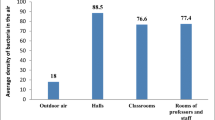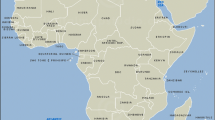Abstract
Air quality, both indoor and outdoor, is closely linked to a range of diseases, including respiratory, cardiovascular and vascular diseases. Therefore, indoor air pollution becomes a very important factor affecting the human health. A study was carried to evaluate the microbial content of indoor pollution in Al-Obour city in the hot arid climate of Greater Cairo, Egypt. Dust fallout samples were collected during year seasons in 2015 from three different sites according to traffic congestion from tested locations. Two parallel samples were taken from indoor and outdoor in all the studied points for comparison. The obtained results show that the number of different microorganisms in all dust samples was higher in the spring season as well as in the first months of the summer compared to winter or autumn seasons in different locations. It is worthy to state that the higher microbial content in falling dust samples was always associated with the high traffic effects from tested points. The higher microbial content was recorded in industrial district compared to other sites of living districts. In addition, microbial content was always higher in indoor samples compared to outdoor samples. Spore-forming bacteria were more common, followed by Staphylococcus, while the least value was reported by Pseudomonas aeruginosa. The predominant fungi genera were Ascospore followed by Cladosporium, Aspergillus/Penicillium. It should increase the application of phytoremediation technology for CO2 mitigation. On the other hand, various factories should be transferred outside the scope of residential blocs, especially in cities with high population density.




Similar content being viewed by others
References
Adhikari A, Sen MM, Gupta-bhatta S, Chand S (2004) Volumetric assessment of airborne fungi in two sections of rural indoor dairy cattle shed. Environ Int 29:1071–1078
AIHA (1996) Field guide for the determination of biological contaminants in environmental samples. American Industrial Hygiene Association, Fairfax
Al-Dabbas M, Abbas MA, Al-khafaji R (2011) The mineralogical and microorganisms effects of regional dust storms over Middle East region. Int J Water Resour Arid Environ 1:129–141
Amann RI, Ludwig W, Schleifer KH (1995) Phylogenetic identification and in situ detection of individual microbial cells without cultivation. Microbiol Rev 59(1):143–169
Berglund B, Brunckreef B, Knoppel H, Lindvall T, Maroni M, Molhave L (1992) Effects of indoor air pollution on human health. Indoor Air 2(1):2–25
Borodulin A, Safatov A, Belan B, Panchenko M (2005) Measurement errors in determining tropospheric bioaerosol concentrations in the southern region of western Siberia, Doklady. Biol Sci 403:260–262
Brown VM, Crump DR, Gardiner D (1992) Measurement of VOCs in indoor air by a passive technique. Environ Technol 13:367–375
Chan PL, Yu PHF, Cheng YW, Chan CY, Wong PK (2009) Comprehensive characterization of indoor airborne bacterial profile. J Environ Sci 21:1148–1152
Cordeiro RA, Brilhante RSN, Pantoja LDM, Moreirafilho RE, Vieira PRN, Rocha MFG et al (2010) Isolation of pathogenic yeasts in the air from hospital environments in the city of Fortaleza, northeast Brazil. Braz J Infect Dis 14:30–34
Demographia World Urban Areas (2016) World agglomerations, 12th annual edition. Frontier Centre for Public Policy, Belleville, IL, pp 112
Domsch KH, Gams W, Anderson TH (2007) Compendium of soil fungi, 2nd edn. Academic Press, New York
Douwes J, Thorne P, Pearce P (2003) Bioaerosol health effects and exposure assessment: progress and prospects. Ann Occup Hyg 47:187–200
Durand KTH, Muilenberg M, Buege HA, Seixas NS (2002) Effect of sampling time on the culturability of airborne fungi and bacteria sampled by filtration. Ann Occup Hyg 46:113–118
Ellis MB, Ellis JP (1997) Microfungi on land plant. An identification handbook. Richmond Publishing, England
Ganyor E (1975) Atmospheric dust in Israel. Sedimentological and meteorological analysis of dust deposition. Ph.D. Thesis, Hebrew University of Jerusalem, Israel
Germain GS, Summerbell R (1996) Identifying filamentous fungi: a clinical laboratory handbook, 1st edn. Star Publishing Company, Belmont
Griffin DW (2007) Atmospheric movement of microorganisms in clouds of desert dust and implications for human health. Clin Microbiol Rev 20:459–477
Griffin DW, Westphal DL, Gray MA (2006) Airborne microorganisms in the African desert dust corridor over the mid-Atlantic ridge, Ocean Drilling Program, Leg 209. Aerobiologia 22(3):211–226
Harrison PT (1997) Health impacts of indoor air pollution. Chem Ind 17:677–681
Harrison R, Jones A, Biggins P, Pomeroy N, Cox C, Kidd S, Hobman J, Brown N, Beswick A (2005) Climate factors influencing bacterial count in background air samples. Int J Biometeorol 49:167–178
Jo WK, Seo YJ (2005) Indoor and outdoor bioaerosol levels at recreation facilities, elementary schools and homes. Chemosphere 61:1570–1579
Kellogg CA, Griffin DW (2006) Aerobiology and the global transport of desert dust—review. Trends Ecol Evol 21:638–644
Kubilay N, Oguz T, Kocak M, Torres O (2005) Groundbased assessment of total ozone mapping spectrometer (TOMS) data for dust transport over the northeastern Mediterranean. Glob Biogeochem Cycles 19:GB1022
Kwaasi AA, Parhar RS, Al-Mohanna FA, Harfi HA, Collison KS, Al-Sedairy ST (1998) Aeroallergens and viable microbes in sandstorm dust. Potential triggers of allergic and nonallergic respiratory ailments. Allergy 53:255–265
Lacey J (1981) Aerobiology of conidial fungi, vol 1. Academic Press Inc., New York
Lyles MB, Fredrickson HL, Bednar AJ, Fannin HB, Sobecki TM (2005) The chemical, biological and mechanical characterization of airborne micro-particulates from Kuwait. In: Abstr. 8th ann. force health protect. conf., session 2586, Louisville, KY
Martiny JB, Bohannon BJ, Brown H, Colwell RK, Fuhrman JA, Green JL, Horner-Devine M, Kane CM, Krumins JA, Kuske CR, Morin PJ, Naeem S, Ovreas L, Reysenbach AL, Smith VH, Staley JT (2006) Microbial biogeography: putting microorganisms on the map. Nat Rev Microbiol 4:102–112
Medrela-Kuder E (2003) Seasonal variations in the occurrence of culturable airborne fungi in outdoor and indoor air in Cracow. Int Biodeterior Biodegrad 52:203–205
Moreno A, Targarona J, Henderiks J, Canals M, Freudenthal T, Meggers H (2001) Orbital forcing of dust supply to the North Canary Basin over the last 250 kyr. Quat Sci Rev 20:1327–1339
New Urban Community Authority, NUCA (2013) New cities. http://www.urbancomm.gov.eg/english/cities.asp. Accessed 25 Mar 2013
Nguyen T, Ilef D, Jarraud S, Rouil L, Campese C, Che D, Haeghebaert S, Ganiayre F, Marcel F, Etienne J (2006) A community-wide outbreak of legionnaires disease linked to industrial cooling towers—how far can contaminated aerosols spread. J Infect Dis 193:102–111
Norbäck D, Nordström K (2008) Sick building syndrome in relation to air exchange rate, CO2, room temperature and relative air humidity in university computer classrooms: an experimental study. Int Arch Occup Environ Health 82(1):21–30
O’Gorman CM, Fuller HT (2008) Prevalence of culturable airborne spores of selected allergenic and pathogenic fungi in outdoor air. Atmos Environ 42:4355–4368
Pastuszka JS, Kyaw Tha Paw U, Lis DO, Wlazło A, Ulfig K (2000) Bacterial and fungal aerosol in indoor environment in upper Silesia, Poland. Atmos Environ 34:3833–3842
Polymenakou PN, Mandalakis M, Stephanou EG, Tselepides A (2008) Particle size distribution of airborne microorganisms and pathogens during an Intense African dust event in the eastern Mediterranean. Environ Health Perspect 116:292–696
Prospero JM, Blades E, Mathison G, Naidu R (2005) Interhemispheric transport of viable fungi and bacteria from Africa to the Caribbean with soil dust. Aerobiologia 21:1–19
Samson RA, Hong SB, Peterson SW, Frisvad JC, Varga J (2007) Polyphasic taxonomy of Aspergillus section Fumigati and its teleomorph, Neosartorya. Stud Mycol 59:147–203
Sautour M, Sixt N, Dalle F, L’ollivier C, Fourquenet V, Calinon C (2009) Profiles and seasonal distribution of airborne fungi in indoor and outdoor environments at a French hospital. Sci Total Environ 407:3766–3771
Schlesinger P, Mamane Y, Grishkan I (2006) Transport of microorganisms to Israel during Saharan dust events. Aerobiologia 22:259–273
Sen B, Asan A (2009) Fungal flora in indoor and outdoor air of different residential houses in Tekirdag City (Turkey): seasonal distribution and relationship with climatic factors. Environ Monit Assess 151:209–219
Shao Y, Yong CH (2006) A review on East Asian dust storm climate, modelling and monitoring. Glob Planet Change 52:1–22
Tate RL III (2000) Soil microbiology, 2nd edn. Wiley, New York, p 508
Tong Y, Lighthart B (2000) The annual bacterial particle concentration and size distribution in the ambient atmosphere in a rural area of the Willamette Valley, Oregon. Aerosol Sci Technol 32:393–403
United States–Environmental Protection Agency (US-EPA): PM Standards Revision (2006). http://www.epa.gov/oar/particlepollution/naaqsrev2006.html. Accessed 9 Mar 2010
World Health Organization (WHO) (2000) Air quality guidelines for Europe, 2nd edn. WHO Regional Office for Europe, Copenhagen
Xiao C, Kang SC, Qin D, Yao TD, Ren JW (2002) Transport of atmospheric impurities over the Qinghai-Xizang (Tibetan) Plateau as shown by snow chemistry. J Asian Earth Sci 20:231–239
Acknowledgements
The authors would like to thank the organizing committee of Indoor Air Quality in Hot Arid Climate Workshop, 3–4 April 2017, Kuwait, for attending the workshop and the financial support to publish this manuscript.
Author information
Authors and Affiliations
Corresponding author
Additional information
Editorial responsibility: Rupali Datta.
Rights and permissions
About this article
Cite this article
Radwan, S.M.A., Abdel-Aziz, R.A. Evaluation of microbial content of indoor air in hot arid climate. Int. J. Environ. Sci. Technol. 16, 5429–5438 (2019). https://doi.org/10.1007/s13762-018-2068-1
Received:
Revised:
Accepted:
Published:
Issue Date:
DOI: https://doi.org/10.1007/s13762-018-2068-1




